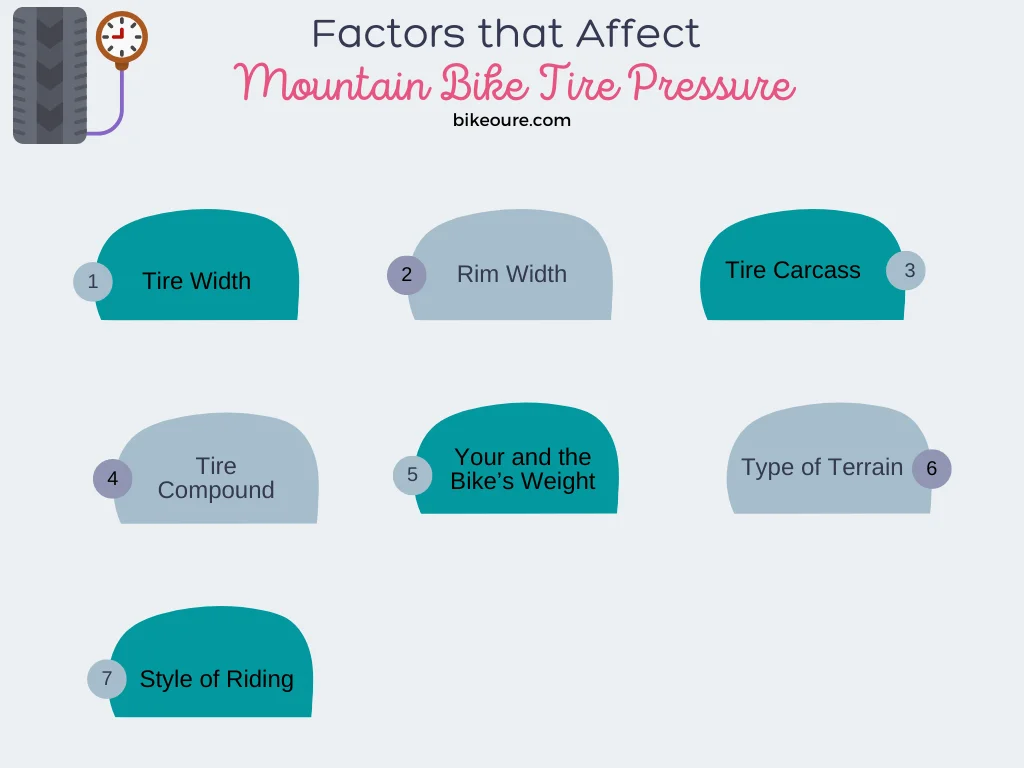The best tire pressure for a mountain bike is between 25 to 35 psi. Listing down the exact mountain bike tire pressure is not possible because numerous factors decide what exact pressure would work in your favor. But, here are a few numbers that you can begin with.
Contents
Best Tire Pressure for Mountain Bike

For a tubeless setup on a trail bike used for riding mixed terrain, with 2.4-inch tires each (rim about 30mm), the suitable pressure for the front and the rear tire is 21psi and 23psi respectively. For 2.6-inch tires taking the same terrain, the appropriate pressure for front and rear tires is 19psi and 21psi respectively.
Likewise, a 2.2-inch tire that has a narrow rim of about 25mm would require a pressure of 24 psi on the front and 26 psi on the rear. Plus, you need to add a few psi to the above-mentioned ones if you are going to be riding a rocky trail. You need to drop down some psi for wet and muddy terrain.
Read a detailed guide on how to inflate Presta valve without adapter
Factors that Affect Mountain Bike Tire Pressure
The pressure of a mountain bike depends on the tire’s width, rim’s width, tire carcass, tire compound, the terrain you are riding, and your style of riding. Therefore, we are going to see how these factors impact pressure:

Tire Width
The width of the tire has an impact on a tire’s pressure. A wider tire has a large volume of air inside. Keep the pressure of a wider tire low because too much high pressure will make it feel skittery. But, you cannot run a lower-volume tire setup with lower pressure.
Rim Width
Wider tires perform well on wider rims and vice versa. If you try to fit a wide tire on a narrow rim, it will result in an imprecise feel. Also, fitting a narrow tire on a wider rim makes it too square and would reduce the cornering lean angles.
Therefore, you can check out the following information to find out which tire width is suitable for which rim width:
- For a rim of width 25mm, mount a tire of 2.2 inches.
- Mount a 2.4-inch tire on a rim ranging between 25 to 30mm.
- A tire of 2.5 or 2.6 inches can mount on a rim between 28 to 35mm.
- Lastly, a 2.8 inches tire can go well with a 35mm plus rim.
Tire Carcass
Brands manufacture different types of carcasses, each serving a specific purpose. A thick carcass is heavy but it prevents punctures. Run a thicker carcass with less pressure, this would make the tire more robust and stable. While for a thin carcass, run it at higher pressure, and you will still get the comfort and grip you want.
Tire Compound
Tire compound means the blend of materials that make up the rubber, you will find some of them softer than others. A soft tire compound gives more grip and traction due to the rubber. You can still add some pressure to it to get more protection and stability, without a change to the grip. Also read a detailed comparison of Presta vs Schrader valve.
Bike’s and the Bike Rider’s Weight
Mountain bike tire pressure for a heavy rider will be high and for a lighter rider low. This is primarily because a heavyweight biker tends to apply greater force on the tires which have to be balanced with higher pressures.
Type of Terrain
Tire pressure must be high if the trail is rough and rocky. This is because greater pressure would lessen the chance of deformation of the tire when you hit a rock or bump. As a result, you do not have to deal with a punctured tire all the time. However, also keep in mind that extremely high pressure can tear apart your tire’s carcass when it hits a sharp edge.
On the other end, a smooth terrain requires the tires to deform so that they can mold to the shape of the ground better and enhances your grip. Also, a track is not always wet and not always dry. So, pressure varies in this regard too.
Style of Riding
The way you ride your bike also decides the pressure your tires need. If you ride your bike smoothly through obstacles, keep the pressure low. But, if your style is more point-and-shoot, go for high pressure.
What should be the Tire Pressure for Mountain Bike on Road?
Keep the pressure of your mountain bike between 35 and 65 psi for riding on the road. This is because high pressure is recommended for roads.
Do You Need an MTB Tire Pressure Calculator?
Yes. Calculating MTB tire pressure and adjusting it with a pressure calculator or a digital pressure gauge can help you get accurate readings and also see how different factors influence the overall performance of your bike.
If the above-mentioned pressures do not work for you, consider them as a starting point and keep on experimenting with your bike to find out the best tire pressure for mountain biking. You can find some more questions related to mountain bike tire pressure answered in the next part.
FAQs about MTB Tire Pressure
What PSI should my MTB tires be at?
Usually, for MTB tires, the pressure range is between 22 psi to 35 psi. Apart from this, maintain a slightly higher pressure for the rear wheel.
What PSI should a 29-inch mountain bike tire be?
If you have a 29-inch mountain bike, the recommended psi for this is between 18 and 28 psi. This pressure also depends on your weight, skills, and the type of terrain you are riding.
Is 40 psi good for mountain bikes?
40 psi is fine for lighter riders when they are starting. But, for a heavier rider, you need to keep the pressure of each tire at around 50 psi. Usually, mountain bike manufacturers recommend keeping the tires’ pressure between 30 and 50 psi.
Final Thoughts on MTB Tire Pressure
Keeping a check on your tires’ pressure is essential as they have direct contact with the ground you are riding on and can thus impact your overall performance. Right tire pressure means improving your mountain bike’s grip, speed, and comfort and allowing you to enjoy it throughout.

Hi, This is Catharine Pendrel, a professional cyclist and founder of Bikeoure. I have been riding bikes for more than 23 years and writing about cycling and other outdoor magazines for about 5 years. Mountain biking has been my passion ever since I first came across it a decade ago. I participated in various MTB tournaments and won numerous mountain trail races.
I started Bikeoure to share my expertise and cycling experience with cyclists all around the world to make them addicted to cycling. My cycling and solo traveling expertise help new cyclists find the best and latest gear in the market for their cycling adventures.